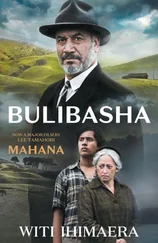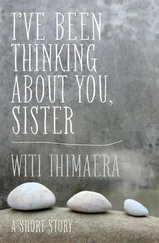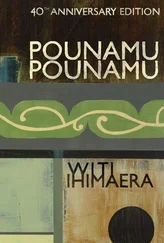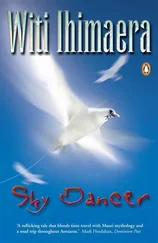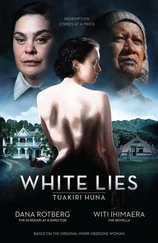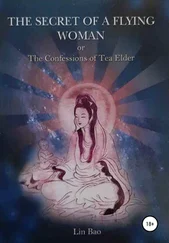Of course the photograph doesn’t show the entire village, only nine good-sized sleeping w’are. It presents a very tidy appearance indeed. Look: down one of the thoroughfares is a streetlamp. Beyond, there’s scrub and a few tall trees. The rest is sky, so the photographer must be looking westward to the sea. Note the village is unfortified.
Now look at the two men at the very back of the photograph. They too stare boldly at the camera, but one stands on the balls of his feet, ready to defend. Horitana, you think?
No, it’s Erenora.
‘I remember the day the photographer took that picture. It was the beginning of winter and on the air was the acrid smell of many cooking fires; the smoke wreathed the sky.
‘I was not surprised at what I looked like in the photograph. It only confirmed what I always saw in the mirror. All my life I was built like a man: tall, wide-shouldered, narrow-hipped and strong-legged. Not for me the ample breasts and thighs and other telltale signs of womanhood.
‘In the photograph I’m wearing a plaid shirt and trousers — yes, trousers — cinched at the waist with a wide belt. I wasn’t above scandalising other villagers, especially my mother Huhana — or even my husband, who sometimes was grumpy that I dressed like a boy. And the illusion that I am a man comes from the fact that my hair is pinned up, whereas Horitana — who also had long hair but wore it, as all the men did, in a topknot — has his long hair down! When that photograph was taken, however, I could sit on my hair.
‘You see, Horitana had got over his shyness of that day when, as a child, I had rescued him from death and tried to wash off his dirt in the stream. Now he enjoyed my bathing him in an old tin tub, and sometimes I would get one ready for him on his return from whatever work Te Whiti had assigned him to do. It might be riding with a squad around the perimeter of Parihaka to ensure that our borders were safe and protected. At other times it might be to keep guard on the fishermen as they went to the sea.
‘I would hurry to get the bath ready, taking my bucket to the well and, one bucketload after the other, fill the copper. Ripeka and Meri sometimes liked to watch me and say to themselves, “Huh! She can’t fool us! Pretending that she wants to wash Horitana’s dust off or get the warmth back into him after a cold day, when we know that what she really desires is to admire his handsome and naked body!”
‘My sisters were still unmarried, though on Ripeka’s part it was not for want of trying, and they were still living with Huhana, whereas Horitana and I had the w’are next door. Ripeka was always the cheeky one, saying to our mother, “Can we go somewhere else to sleep tonight? All the noise as Erenora bathes Horitana, the splashing and the sighing. What can they be doing?” Ripeka’s thoughts were so salacious.
‘Once I filled the copper I lit the fire beneath it and heated the water. Then, bucket by bucket, I filled the bath … and waited … and when Horitana arrived home, I would put a candle on the rim of the tub and invite him to clean himself. “Oh, wife,” he would shiver in anticipation. The tub wasn’t very big, but I loved bending his limbs so that he could fit into it. He was tall and lean-muscled and, yes, I will admit that I got much pleasure in looking upon him.
‘“Is the water hot enough?” I would ask. I washed and soaped him and asked him to let down his hair so I could wash that too. Sometimes I sang to him, to tell him why I loved him: “Softly, you awoke my heart, you put your arms around me and sheltered me from sorrows deep and asked the mountain me to keep! Since that day I have loved you so, wherever you go I go too!”
‘I will admit that often I wished the tub was big enough for both of us.
‘And sometimes Horitana would responded to my song with his own: “From the moment I first saw you, dearest wife, I carried your face in my heart! The thought of you sustained me even though we were far apart! Respond to me, my Erenora, respond again, Erenora …”
‘We loved those times together, Horitana and I, except that finally that impudent sister of mine, Ripeka, would shout from next door, “Oh, hurry up you two and get on with it!”’
Look at the photograph again. In my opinion, Horitana has indeed just come from a bath, so the photograph must have been taken in the late afternoon; the photographer would have been anxious to capture the image while he still had enough light.
Horitana may even have come from lovemaking. His skin glows , don’t you think? Everything about him glows, his eyes, his hair, even his chest, over which he has hastily thrown a blanket.
And Erenora definitely looks like someone to be reckoned with, eh? Even though it’s only a photograph that’s being taken, she has flung her arms around Horitana’s shoulders as if he is imperilled in some way.
CHAPTER SIX
A Prophet’s Teachings
On what principles did Te Whiti base his creed?
Bernard Gadd has written about this in his article which covers the teachings of Te Whiti better than I ever could. He says that ‘Te Whiti did not carefully systematize his theology, but the principal strands in his thinking stand out clearly.’
His fundamental conviction was that God was sovereign in His universe and that nothing existed or occurred but by His will. Te Whiti said in October, 1880 that all things were ordained at the beginning of the world … namely wars and dissensions … We could not have altered anything hoewever we might strive . [5] Bernard Gadd, ‘The Teachings of Te Whiti O Rongomai, 1831–1907’, Journal of the Polynesian Society , 1966, Vol. 75, No. 4, p. 448. Te Whiti’s quotation is cited from G.W. Rusden, A History of New Zealand , 3 vols, Chapman & Hall, 1883, Vol. 3, p. 259.
In Gadd’s words, ‘the heart of Te Whiti’s creed and that which drew people to him was his confident reaffirmation that the Maori “had not been lost sight of by the Great Ruler, who kept all things in good order”’:
‘God has protected us and will protect the land and the people … You are a chosen people and none shall harm you.’ [6] Gadd, ‘Teachings’, p. 449. Quotations are cited, in order, from New Zealand Herald , 18 October 1881; Rusden, History , Vol. 3, p. 291.
Aren’t Te Whiti’s utterances inspiring? I particularly like this one: ‘The ark by which we are to be saved today is stout-heartedness, and flight is death.’ No wonder Parihaka became a symbol of hope and an emblem of Maori sovereignty, not only to Taranaki tribes but also other iwi in Aotearoa. You have to shake your head, though, and wonder why did the prophet choose such open ground to build Parihaka on, and with no defensive walls and ramparts? What was Te Whiti thinking ?
Well, first he was proclaiming pride in ownership. Perhaps he was also sending a message to Pakeha that he was not afraid of them.
He was certainly sending a message to Maori that he and the people of Parihaka were not in hiding. When you think of it, his full name, meaning ‘The shining path of the comet’, couldn’t be more apt. It shouldn’t be surprising that Maori were drawn to that flightpath, to follow in its glowing wake to Parihaka, as the three wise men did to Bethlehem.
Maybe Te Whiti was also sending a message to God:
‘Just in case you can’t find us, here we are.’
‘The main tribal meetings,’ Erenora wrote, ‘took place on the 18th of each month, Te Whiti’s special Sabbath — actually the 17th by calendar date, because Te Whiti argued that Pakeha had left out the day the “Sun stood still”.
Читать дальше


